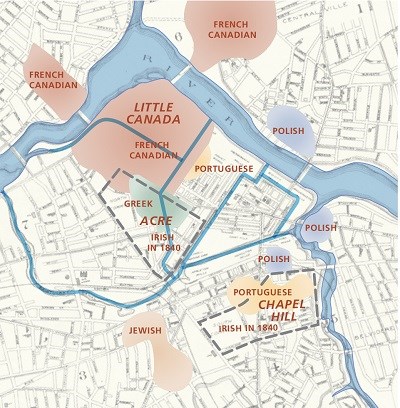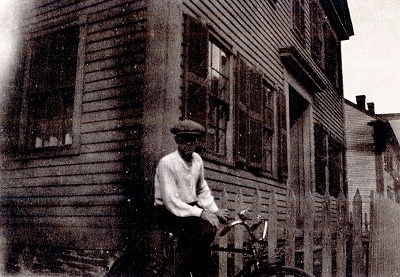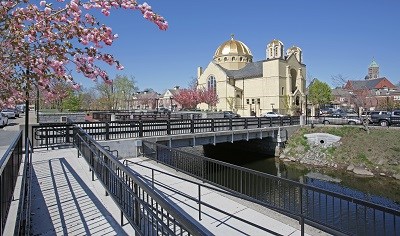IntroductionThe “Acre,” one of Lowell’s earliest ethnic neighborhoods, reflects a diversity of cultures resulting from over 170 years of migration. On a walk through the Acre, one might hear the driving beat of Latino music and smell native foods like sousi pa, kai lao, cabbage, and taskebap. Southeast Asian and Greek restaurants coexist on the same block. The most striking juxtaposition is the steeple of St. Patrick’s Irish Catholic Church reflected in the golden, Byzantine dome of Holy Trinity Greek Orthodox Church. The diversity is visible in the faces of the children who speak English while playing with friends, but respond to their parents in their native Khmer, Spanish, or Portuguese. The stories of these families echo those of many immigrants who settled in the Acre with little but their dreams, beginning with the arrival of Irish in the early 1820s. 
The Acre EmergesIn 1822, about 30 male Irish laborers walked from Boston to the rural village of East Chelmsford to build the canals, factories, and boardinghouses that gave rise to the industrial city of Lowell. Some Irish men and women found employment in the textile factories and a few resided in boardinghouses or tenements. Many Irish men, however, continued to work as laborers and builders. They lived with their families in ramshackle wooden cabins in a swampy area on the outskirts of town known as the “Paddy Camp Lands” or “New Dublin.” Makeshift street patterns developed as the Irish settled alongside kinfolk and clan in ways that resembled settlement in their native counties. The growth of Lowell’s Irish population concerned the town’s founders. Many of the Yankee elite believed that the newly arriving Irish posed a threat to their values of thrift, sobriety, and hard work. Tensions between Protestant Yankees and Catholic Irish, as well as within the Irish community, occasionally flared into violence. Seeking stability within the Irish Acre, Merrimack Mills agent Kirk Boott donated a plot of company land for a Catholic church. In 1831, St. Patrick’s Church was completed. The church and its towering spire marked the permanent settlement of the Irish in Lowell. 
OpportunitiesThe population of the Acre grew rapidly in the 1840s as Irish immigrants, who were escaping poverty and famine in their homeland, streamed into Lowell. At the same time, Yankee “mill girls” organized turnouts for higher wages and a shorter (ten-hour) workday. The availability of unskilled jobs attracted poor immigrants, in spite of long hours and low pay. Mill managers hired these new arrivals and thereby blunted the protesters’ efforts. The Civil War disrupted the textile industry in Lowell, casting many Irish into poverty while forcing others out of the city. When production fully resumed in the late 1860s, new immigrants began arriving in Lowell. Over the next 40 years, the city became home to a number of ethnic groups including additional Irish, French Canadians, Greeks, Portuguese, Poles, and Eastern European Jews. By the early 1900s the Acre contained primarily Irish and Greeks. Crowded into tenements, entire families often shared one room with no running water. As more and more of the established Irish moved to neighborhoods away from the Acre, new arrivals readily took their places. 
The Great Depression of the 1930s hit Lowell hard, especially affecting residents in the Acre. Textile mills closed and workers suffered from massive layoffs and deteriorating neighborhoods. To improve the Acre’s dilapidated, overcrowded housing, the city used federal funds to tear down several blocks of buildings and construct a project called North Common Village. This public housing was one of the first federally funded urban renewal projects in the United States. The destruction of tenements, restaurants, and shops, however, dramatically changed the face of the Acre as many families moved elsewhere.
The post-World War II era marked the arrival of new immigrants. One factory owner recruited skilled male textile workers from Colombia to operate the mill’s aging machines. These men settled in the Acre, and their families soon joined them. Additional Spanish-speaking immigrants, including Puerto Ricans and, more recently, Dominicans, settled into the Acre. Like immigrants before them, Latinos often encountered economic hardship and racism. Yet they brought vitality into one of the city’s oldest neighborhoods and endowed Lowell with another new and vibrant culture. 
James Higgins The Acre TodayLike other immigrants, Southeast Asians came to Lowell seeking a better life. They fled their war-torn countries of Cambodia, Laos, and Vietnam in the late 1970s. To aid these immigrants, Congress passed the Refugee Act (1979), which provided federal funds to Lowell and other cities that had growing Southeast Asian populations. Many Southeast Asians settled in the Acre in the early 1980s. They gained an economic foothold in Lowell through industrial jobs or through jobs in the expanding computer industry, chiefly Wang Laboratories, the city’s largest company. The collapse of Wang in the late 1980s, however, left many people without jobs. Today, members of the community, clergy, and local organizations such as the Coalition for a Better Acre are attempting to improve the physical quality of the Acre and provide better social services for its residents. Yet social and economic struggles continue to confront Acre residents. The Acre’s long history as a neighborhood of immigrant people reflects the many challenges and opportunities that have characterized urban life not only in Lowell, but also in America. |
Last updated: February 10, 2025
